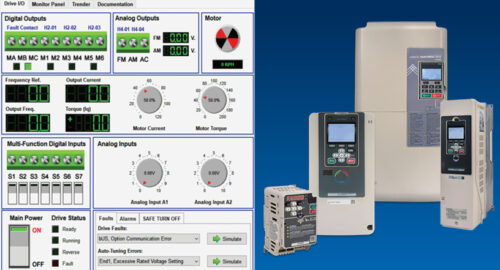Software, hardware, and information can lower maintenance costs
Perhaps everyone’s heard the story about the accountant who was lost and phoned his engineer friend for directions. "Look up at the street sign," advises the engineer on the phone: "What corner are you on?" The accountant looks and says, "I’m on the corner of Walk and Don’t Walk."
Perhaps everyone’s heard the story about the accountant who was lost and phoned his engineer friend for directions. “Look up at the street sign,” advises the engineer on the phone: “What corner are you on?” The accountant looks and says, “I’m on the corner of Walk and Don’t Walk.”
Huge savings exist at the intersection of controls and maintenance. Many people in each area continue to speed on by without stopping, although some seem to be a slowing down to take a look. And if you feel like you’re the one who’s lost, there is still hope. Most automation, control, or instrumentation equipment and software can provide some information to help predict when maintenance is needed. Some tools offer more specialized diagnostics and data analysis capabilities. Here’s a sampling of what’s available, from more than 25 companies (by no means a complete list).
Among offerings from ABB are ABB OptimizeIT Real-Time Production Intelligence software and ABB OptimizeIT Asset Optimizer software. (Links on the product names go to prior Control Engineering coverage.) OptimizeITReal-TPI consists of a data acquisition module, a data manipulation and storage module, and modules for visualization and reporting. Each module can be distributed over a local area network from practically any programmable logic controller or distributed control system. Highly versatile, OptimizeITReal-TPI retrieves and exports data to and from relational databases, XML reports with Web browser access, and reads values from text files, all of which make it possible to get production data automatically.
ABB OptimizeIT Real Time Production helps analyze cycle-time losses.
AMR Research comments on various maintenance-related developments, including a Dec. 19, 2003, piece from Nigel Montgomery called, “EAM: For When Fail-ure or Replacement Are Not Options.” AMR’s Montgomery says, “Global nuclear energy com-pany British Nuclear Fuels (BNFL) will use Intentia’s Enterprise Asset Management (EAM) sys-tem to aid in critical preventive maintenance for its facilities…. The contract between BNFL and Intentia, worth more than EUR 1.5M, will be implemented in six phases, starting with BNFL’s large installation at Sellafield, Northern England. BNFL is a high-profile example, but it repre-sents just one part of a rising need for all companies to ensure effective preventive maintenance to protect the available time of heavily utilised assets, especially when replacement is postponed during economic hard times.”
Avantis unit of Invensys products include “real-time enterprise asset management and condition monitoring to large and mid-size organizations. Benefits of real-time enterprise asset management include improved access, availability and utilization of all assets,” the company says. Enhanced Avantis.XA asset management software provides “large, capital-intensive organizations with a comprehensive asset management solution to maximize equipment uptime and help eliminate costly, unplanned breakdowns.” Release 3.2 enhancements for IBM’s AS/400 hardware suite are available immediately, at no charge to customers with an annual support agreement.
In other recent news, Bernard Matthews Ltd., signed an agreement to deploy the Avantis Enterprise Asset Management (EAM) solution at all six U.K.-based facilities Bernard Matthews produces fresh, chilled and frozen turkey products. Factories and the milling division will use the software to im-prove equipment maintenance management and streamline corporate purchasing. “Avantis will enable us to replace three purchasing systems with a single solution. Avantis addresses both our CMMS and MRO material demands and meshes smoothly with our ERP system,” said Malcolm Carr, Bernard Matthews director of information systems. In other news, Bermuda Electric Light Company Ltd. signed an agreement to deploy the Avantis EAM solution to assist in managing the island’s self-sustaining power generation and distribution operations.
Balmac Inc . Model 550-CSA Vibration Switch monitors rotating machinery operating at 120-60,000 rpm, detecting excessive vibration form unbalance, worn bearings, mechanical looseness, and broken parts. Features include two adjustable vibration limits with time delays, limit LED indicators, a system test button and automatic limit resets. Housing is water-tight; it’s CSA certified for U.S. and Canadian markets.
ClickSoftware integrates with Caterpillar’s existing communications software to improve the service process and technician dispatching, increasing speed dependability, and efficiency of field engineers up to 30%, ClickSofware says. Information includes time of technician arrival, time to completion, and other expectations.
Datastick Systems and Oceana Sensor Technologies developed a software interface for Palm OS Bluetooth extensions for communications with Oceana Sensor’s Wireless e-Diagnostics System products. The result, the companies, say, is the “first fully functional handheld wireless machine health monitoring system” that allows maintenance engineers and asset managers to have one source to obtain critical predictive maintenance information from route-based data collection activities, using off-the-shelf Palm Tungsten handheld. Display includes the first software to display Fast Fourier Transform spectra on such a PDA. Oceana claims industry could save up to $115 billion annually through reduction of unscheduled maintenance and downtime.
U.S. Department of Energy’s Office of Industrial Technologies mentions preventive maintenance activities in context of ” Assessment Study: Sensors and Automation in the Industries of the Future ,” in part, looking at “planning, scheduling, and control to reduce energy costs….” Other areas of the site discuss “convincing management” to fund CMMS, maintenance budgets, and related topics.
For plants without networked diagnostics, mobile collection units can be used, such as this 2130 RBMconsultant PRO data collector, which features the functionality and ease of a large color display.
Emerson Process Management combines predictive maintenance techniques with comprehensive analysis tools with the AMS Suite: Machinery Health Manager, which determines the condition of mechanical equipment, including rotating machinery and static equipment. AMS Machinery Manager version 4.81 (previously known as RBMware) supports online and route-based equipment monitoring, data management, and data analysis for vibration, infrared thermography, oil analysis, ultrasonics and motor diagnostics; corrective tools for balancing and laser alignment; and cost analysis, case histories and reporting. AMS Machinery Manager helps document, trend and communicate all details of machinery health, to gauge accurate asset condition, advise appropriate actions, prioritize and plan daily maintenance activities. In September 2003, the company announced a three-year collaboration contract that appoints Emerson as global supplier of a selection of Machinery Health Management technology to Alstom , to provide equipment, training, and consultancy in developing the use of the machinery health management techniques within Alstom’s train servicing centers. Alstom is said to welcome the potential of applying the multi-technology platform, initially by utilizing vibration, stresswave, and ultrasonic condition-based maintenance equipment and techniques within its maintenance programs.
EPRIsolutions , a consulting service for electric utilities, says predictive maintenance lowers costs by deferring routine maintenance and detecting problems before a forced outage, resulting in overall reduction in plant maintenance expenditures of 15-20%. Less downtime increases availability of generating resources.
Monitoring instruments, such as ifm efector’s Metris, can signal when an air system is leaking and needs attention
HSB Reliability Systems Group uses historical profiles based on equipment and industry application. Production can increase by 20% and maintenance costs fall by 10-20%, without investing in additional capital assets, through better global reliability practices, according to the company, which uses an equipment database with more than 350,000 profiles. Additional benefits include reduction of emergencies by 30-75%, decreased maintenance overtime by 40-50%, 30-40% savings in parts purchases, and 10-12% lower energy production.
ifm efector predictive maintenance compressed air sensor, efector Metris, monitors air consumption and detects leakage to improve energy efficiencies, tool and equipment efficiencies, lower system moisture, and achieve more consistent system pressure. Leaks can waste 20-30% of compressor output. Mounted to a supply for one machine or zone, Metris compares ideal air consumption to actual, using a calorimetric flow sensing principle. It has 4-digit numeric display (with three display options) and microprocessor-based pushbutton setup. Model SD6001 has a 1/2-in. NPT connection with measuring range of 0-44 scfm and SD8001 has 1-in. NPT connection with measuring range of 0-132 scfm.
ISO (International Or-ganization for Standardization), in October 2003, announced a new standard, ISO 13374-1:2003 , Condition monitoring and diagnostics of machines—Data processing, communication and presentation—Part 1: General guidelines. Goal is to “allow data and information from condition monitoring systems to be processed, communicated and displayed by various software packages without platform-specific or hardware-specific protocols.” The new standard provides guidelines for software specifications, which can be used to create an interface between condition-monitoring technologies and the software packages that interpret their data. It is designed to enable users to assess the current health of the machine, predict future failures and assist them in generating and transmitting recommended actions.
According to Ken Bever, convenor of the working group that developed the new standard, ISO 13374-1 is expected to result in cost savings for users by removing the need for extensive and costly integration efforts. The cost of in-house integration of this specialized data is extreme, he says; “The value of the technology is significantly reduced when it cannot be easily electronically shared and stored. Integration efforts are time-consuming and costly. Even if an integration effort is completed, the software maintenance costs are estimated to be 20% of the initial integration cost per year.” ISO says the new standard targets suppliers of machine condition-monitoring systems and end-users who desire plug-and-play machinery condition-monitoring software and information compatibility.
Macsea Ltd . provides software for prognostic machinery health monitoring. The company signed a recent contract with Electric Boat Corp. (a General Dynamics Co.) to develop and demonstrate real-time maintenance decision-making for highly automated networked information infrastructure with wireless sensors, neural-network-based diagnostics/prognostics and intelligent software agents. Technology will likely be used in the new Virginia-class submarines. The U.S. Navy has widely used Macsea’s Dexter Agents to reduce maintenance costs.
Manugistics is among data analysis software providers. Software such as Statgraphics builds expert regression models to determine success or failure based on multiple variables.
MIMOSA is a non-profit trade association established to develop and encourage adoption of open information standards for operations and maintenance. Members in-clude process and discrete manufacturing corporations, facility management companies, military organizations, capital equipment OEMs, and suppliers of asset management software systems in-cluding human-machine interfaces (HMI), manufacturing execution systems (MES), plant asset management (PAM) systems, enterprise asset management (EAM) systems, operational data his-torian systems (ODHS), and condition monitoring (CM) systems.
There’s an opportunity to help shape the future by participating in the OpenO&M initiative (a coordinated set of open standards for operations and maintenance information). The annual MIMOSA spring business meeting has been scheduled for April 28-29, 2004, in Scottsdale, AZ. Interested industry participants are invited to attend the open meetings and presentations on April 29, 2004. The MIMOSA Technical Committee will meet on Tuesday, April 27, 2004. Additional agenda and registration information is available at www.mimosa.org. (MIMOSA considers OpenO&M its trademark.) See related Control Engineering story: ” ISA Expo 2003: OPC moves to web services, XML; collaborates with MIMOSA, ISA “
National Instruments hardware and software can help maintenance activities by monitoring, collecting, and analyzing data. National Instruments Lookout HMI/SCADA software and FieldPoint distributed I/O system can optimize manufacturing production efficiency, finding critical areas of disruption and reporting findings to the operator. Loss analysis can assist in decisions on maintenance and continuous improvement, leading to greater machine utilization and improved manufacturing profitability.
New Standard Institute offers Maintenance Management Seminars, March 22-26 in New Orleans, LA, covering planning and scheduling and leadership skills.
Omron Electronics Smart DeviceNet Remote I/O Terminals help gather and use information for effective preventive maintenance by building cost-effective, parallel information systems for control and maintenance. These remote I/O terminals include economical expansion units to design a monitoring system for maintenance.
Some industrial networks, such as Interbus, offer diagnostic capabilities. Phoenix Contact Diag+ software helps organize error message for prompt attention.
Phoenix Contact offers Diag+ diagnostics software to help create user expertise by providing clear text messages and even possible error causes instead of error codes. Using a knowledge database stored in the software, important notes and tips can be given for error removal by recording and providing fieldbus diagnostic data, based on long-established standards defined by Microsoft.
Rockwell Automation ’s XM-122 gSE Vibration Module is an intelligent 2-channel, special-purpose monitor suited for monitoring of vibration in rotating equipment fitted with rolling-element bearings. XM-122 has circuitry and firmware that enable it to measure standard vibration (like the XM-120), and g’s Spike Energy (gSE). gSE is an Entek developed signal-processing technique that provides an accurate measure of the energy generated by transient or mechanical impacts. Other modules measure a variety of other parameters useful for tracking equipment wear.
Entek EtherNet/IP Gateway connects an XM DeviceNet network and a facility’s Ethernet. XM Gateways offer a standard TCP/IP interface and support EtherNet/IP and Modbus/TCP protocols.
Sandia National Laboratories is developing a predictive maintenance system (WinR-PdMTM ) that makes use of equipment maintenance records to focus attention on key failures that lead to equipment unavailability and downtime. Sensors are then employed to monitor important indicators of equipment performance. Real-time sensor data are combined with information from ongoing equipment maintenance to constantly update equipment failure predictions and to identify the most likely causes of failure. The software is installed on a flexible manufacturing system (FMS) at AlliedSignal Federal Manufacturing and Technology center in Kansas City. The FMS consists of 6 milling machines, 2 wire-guided robots, 2 coordinate measuring machines, a wash station, and a central coolant distribution system.
SAP Product Lifecycle Management tools from SAP and others help tie in maintenance activities to overall enterprise activities and may help justify additional expenditures.
Encoders, such as one from Sherborne Schaevitz used in this paper mill application, record information like frequency, internal temperature and operating time.
Sherborne Schaevitz says in some processes stopping to check encoder reliability can cost more than the encoder itself. Built-in diagnostics monitor continuously and alert an operator so maintenance can be scheduled prior to failure, during the next convenient time.
SmartSignal SmartSignal eCM is an enterprise software solution with a browser-based GUI that provides real-time asset health monitoring for large industrial assets like combustion turbines, jet engines, diesel engines, pumps, electric motors, meters and, in fact, almost any instrumented mission-critical asset with installed sensors.
Large rotating machinery, mobile or stationary, are among applications appropriate for SmartSignal eCM software that provides real-time asset health monitoring with ability to predict early failures.
SmartSignal looked at past equipment failures to see just how much advance notice eCM could have provided. Smart-Signal analysis of sensor data preceding real operating incidents showed eCM would have given early warnings of: 6 days before a combustion turbine failed abruptly; 3 days before a steam turbine shut down; 9 days before a jet engine failure grounded a plane in a remote airport; and 11 days notice of an locomotive diesel engine failure.
U.S. Pacific Northwest National Laboratory (PNNL) has developed an intelligent diagnostic software program that increases productivity and helps ensure equipment runs efficiently. Decision Support for Operations and Maintenance (DSOM) software can reduce a facility’s lifecycle operations and maintenance costs by 25-50%. DSOM was originally devel-oped for the U.S. Marine Corps. In 1994, it was installed at the central heating plant of the Marine Corps’ Air Ground Combat Center in Twentynine Palms, CA. From 1994 through 2003, the facility reduced its O&M expenses by 33%, saving about $500,000 a year in lifecycle operations and maintenance costs. PNNL is operated by Battelle Memorial Institute for the U.S. Department of Energy.
Wago Ethernet TCP/IP programmable fieldbus controller (PFC 750-841) can gather diagnostic information that can be analyzed for maintenance use.
Wonderware plant intelligence software takes information and allows analysis and alarming to help optimize predictive maintenance efforts. Related conferences run March 19-April 15 in six U.S. cities. Automation software can tie into and assist preventive maintenance. In the case of Wonderware, these would include: IndustrialSQL Server is said to acquire real-time production data at full resolution, and seamlessly incorporate non-real-time, manual and/or off-network data. Each can help in predicting when an asset needs attention. ActiveFactory provides trending data analysis over time. DT Analyst : Downtime Tracking & Production Monitoring System provides insight into the events that cause production systems (or their components) to stop functioning. QI Analyst : SPC software system that enables manufacturers to use real-time data to monitor, predict and make online adjustments for production quality and consistency.
Related coverage For additional related companies providing related products and services, visit the Control Engineering Buyer’s Guide . (registration required).
For plant maintenance for process control, see these Control Engineering articles:
” Optimizing Assets Requires Well- ‘Tuned’ Resources and the Right Attitude “
” Maintaining a Single Source of Truth “
” Product Focus: To fieldbuses, intelligent devices, enterprise-level and beyond! “
” Learning from the Other Guy: Benchmarking and Best Practices “
” SPC/SQC Closes the Loop “
Watch for the Control Engineering March 2004 edition for a cover story on Maintenance and Controls. Click here to renew your print subscription .
—Mark Hoske, Editor-in-Chief, Control Engineering, MHoske@cfemedia.com
Do you have experience and expertise with the topics mentioned in this content? You should consider contributing to our CFE Media editorial team and getting the recognition you and your company deserve. Click here to start this process.





